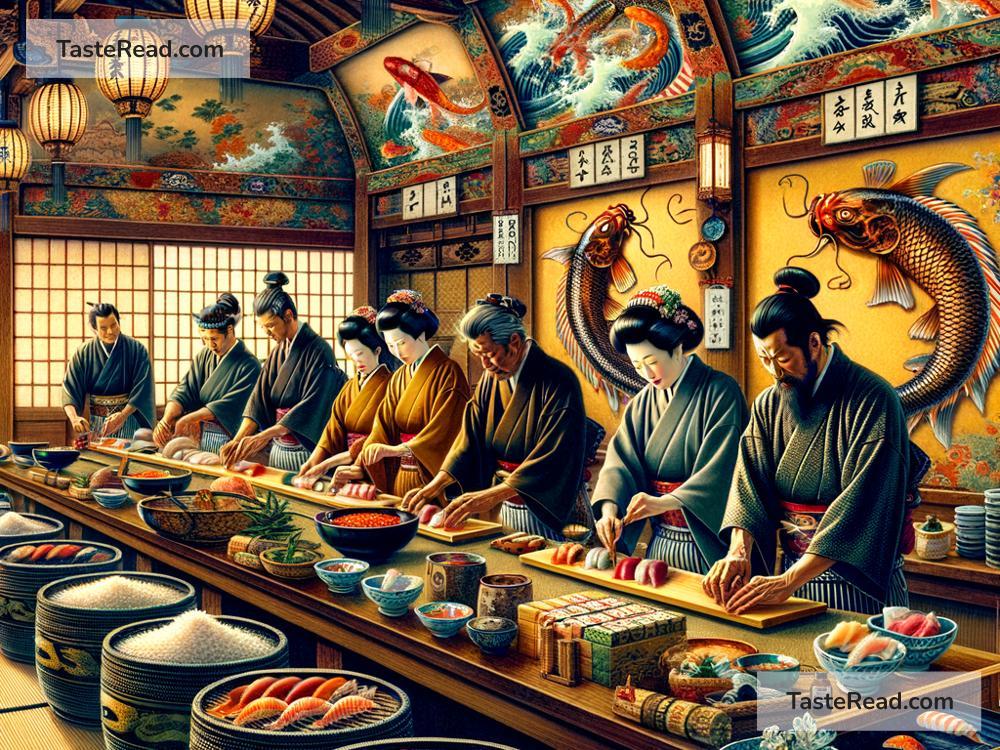The Origins of the First Sushi Roll in Folklore
Sushi rolls are one of the most popular dishes enjoyed around the world today. They come in many shapes, sizes, and flavors, from traditional rolls with fresh fish to modern versions packed with creative ingredients. But have you ever wondered how the sushi roll was first created? While historians often look to old cooking practices and traditional Japanese food as its origin, there are also fascinating bits of folklore that tell whimsical stories about how the sushi roll came to be. Let’s explore some of these legends in simple, easy-to-understand language!
What Is Sushi?
Before we dive into the folklore, let’s first understand what sushi is. Sushi is a Japanese dish that typically consists of rice seasoned with vinegar, combined with fish, seafood, vegetables, and sometimes fruit. Some sushi comes in rolls, which are made by wrapping the ingredients together using a thin sheet of dried seaweed (called nori). These rolls are cut into bite-sized pieces, making them easy and fun to eat.
Sushi has been enjoyed in Japan for centuries, but sushi rolls, also known as maki, likely developed later in history. While the true invention of sushi rolls is tied to evolving food trends, folklore offers some playful explanations for how they may have come to life.
The Tale of the Fisherman and the Seaweed
One Japanese folk story tells the tale of a fisherman named Hiroshi who lived by the sea. Hiroshi loved catching fish and experimenting with different ways to prepare them. One day, after a long day of fishing, Hiroshi realized he didn’t have anything to use as a plate for his meal. The seawater had washed away his cooking tools, and he was hungry and desperate to eat.
While searching for a solution, Hiroshi spotted some dried seaweed floating near the shore. He picked it up and noticed that it formed a flat, sturdy sheet. Inspired by the idea, he decided to wrap his freshly caught fish in the seaweed, along with some rice he had stored in his pouch. It was the perfect way to keep his meal together while eating—no fancy tools were needed!
Hiroshi shared his discovery with fellow fishermen, and before long, this clever way of preparing fish became a popular idea among the coastal towns. People soon began adding different ingredients and rolling them up in seaweed, creating what we now know as sushi rolls!
The Princess and the Rice Scroll
Another folk tale links the creation of sushi rolls to royalty. Long ago, there was a kind and creative princess named Ayumi who loved to host grand feasts for the people of her kingdom. One day, she decided she wanted to serve rice and fish at her banquet, but she noticed that the guests struggled to pick up the rice and fish neatly with their hands.
Determined to solve the problem, Princess Ayumi sought inspiration from her calligraphy scrolls, which were rolled neatly into tubes. She had an idea—what if she could roll the rice and fish carefully into edible “scrolls”? She called upon the castle’s chef and asked for thin sheets of dried seaweed to use as wrappers. Together, they began wrapping rice, fish, and special sauces into small rolls.
At the banquet, the guests were delighted by the princess’s invention. They loved the bite-sized creations and could eat without making a mess. People in the kingdom praised Princess Ayumi’s clever idea, and soon the sushi roll became a staple in royal parties and homes across the region.
The Dragon’s Gift
One of the more magical stories about sushi rolls involves a mythical dragon named Ryujin, who lived deep in the ocean. According to legend, Ryujin was a protector of the seas and loved sharing knowledge with humans. One day, a brave fisherman named Kenta ventured far into the ocean and accidentally stumbled upon Ryujin’s underwater palace.
Rather than being angry, Ryujin welcomed Kenta and offered him a special meal wrapped in seaweed. The dragon explained that wrapping food kept the flavors fresh and combined all the ingredients beautifully. Kenta returned to his village with this knowledge and began teaching others how to enjoy food this way. Over the years, the dragon’s recipe transformed into sushi rolls, and people always remembered Ryujin’s gift as a blessing from the sea.
Folklore Meets Reality
While these legends capture the imagination, the real history of sushi rolls is more practical. Sushi itself dates back over a thousand years to a food preservation method involving fermented fish and rice. Over time, sushi evolved with Japan’s changing culture. By the Edo Period (1603–1868), vinegar was used instead of fermentation, and sushi became a more modern, portable dish.
Sushi rolls likely emerged when chefs began experimenting with seaweed to wrap rice and fish together. It was a convenient way to prepare sushi that could be enjoyed on the go or shared easily during meals. Folklore, though fun and magical, helps illustrate how food ideas like sushi rolls may have sparked creativity among people in the past.
Conclusion
The sushi roll has a rich history of innovation and tradition, blending real-world culinary evolution with enchanting folklore. Whether it was a clever fisherman, a creative princess, or a wise dragon, these tales remind us of the imaginative ways humans have solved problems throughout history. Today, sushi rolls continue to delight people across cultures and serve as a reminder of how a simple idea can become something extraordinary.
Next time you enjoy sushi, take a moment to think about its journey—both real and mythical—from Japan’s past to your plate. Who knows? Maybe Hiroshi, Ayumi, or even Ryujin the dragon played a part in inspiring the food we love today!


